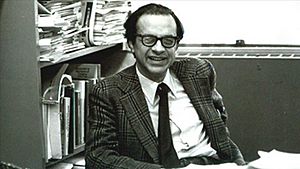Feza Gürsey facts for kids
Quick facts for kids
Feza Gürsey
|
|
|---|---|
 |
|
| Born | April 7, 1921 |
| Died | April 13, 1992 (aged 71) |
| Alma mater | |
| Known for |
|
| Parent(s) |
|
| Scientific career | |
| Fields | Mathematical Physics |
| Institutions |
|
| Thesis | Applications of Quaternions to Field Equations (1950) |
| Doctoral advisor | Harry Jones |
| Doctoral students |
|
Feza Gürsey (Turkish pronunciation: [ˈfeza ˈɟyɾsej]; April 7, 1921 – April 13, 1992) was a brilliant Turkish mathematician and physicist. He made very important discoveries in theoretical physics. His work on the Chiral model and SU(6) are some of his most famous contributions.
Contents
Early Life and Education
Feza Gürsey was born on April 7, 1921, in Istanbul, Turkey. His father, Reşit Süreyya Gürsey, was a military doctor. His mother, Remziye Hisar, was a chemist and one of Turkey's first female scientists.
Feza Gürsey went to Galatasaray High School and finished in 1940. He then studied Mathematics and Physics at Istanbul University, graduating in 1944.
A Career in Physics
After university, Feza Gürsey received a scholarship from the Turkish Ministry of Education. This allowed him to study for his doctorate degree in the United Kingdom. He went to Imperial College London. In 1950, he finished his work on how special math tools called quaternions could be used in quantum field theory.
From 1950 to 1951, he continued his research at Cambridge University. Then he returned to Istanbul University as an assistant. In 1952, he married Suha Pamir, who was also a physics assistant. By 1953, he became an associate professor.
Research in the United States
Between 1957 and 1961, Gürsey worked at several famous places in the United States. These included Brookhaven National Laboratory, the Institute for Advanced Study in Princeton, New Jersey, and Columbia University.
In the 1960s, he focused on complex physics ideas. He studied something called the nonlinear chiral Lagrangian. His discoveries helped us understand quantum chromodynamics, which is about the strong forces inside atoms.
Return to Turkey and Yale
In 1961, Feza Gürsey came back to Turkey. He became a professor at Middle East Technical University (METU). He also helped start the Theoretical Physics Department at METU. He taught there until 1974 and built a strong research team.
In 1965, Yale University in the United States offered him a job. So, he worked at both Yale and METU for a while. In 1974, he decided to stay at Yale full-time. During these years, he helped create theories like E(6) grand unified theories. These theories try to combine all the basic forces of nature.
Legacy and Honors
Feza Gürsey passed away in 1992 in New Haven, Connecticut. He is remembered through his son, Yusuf Gürsey.
Many places and awards honor his contributions to science:
- The Feza Gürsey Institute in Istanbul, Turkey, is named after him. It was created by Boğaziçi University and TÜBİTAK.
- The Feza Gürsey Science Center in Ankara is also named in his honor.
- Boğaziçi University keeps an archive of his work.
- You can find sculptures of him in Turkey, like one by Charlotte Langlands at the Nesin Mathematics Village.
Awards and Recognitions
Feza Gürsey received many important awards for his work:
- 1969 Scientific and Technological Research Council of Turkey (TÜBİTAK) Science Award
- 1977 J. Robert Oppenheimer Memorial Prize (shared with Sheldon Glashow)
- 1977 A. Cressey Morrison Prize in Natural Sciences (shared with R. Griffiths)
- 1981 Collège de France Award
- 1983 Honorary title of "Commendatore" from Italy
- 1986 Wigner medal
- 1989 Award of Association of Turkish - American Scientists and Engineers
- 1990 Galatasaray Foundation Award

